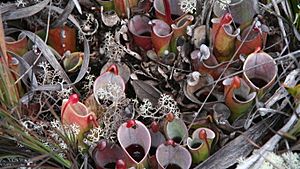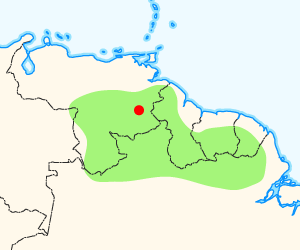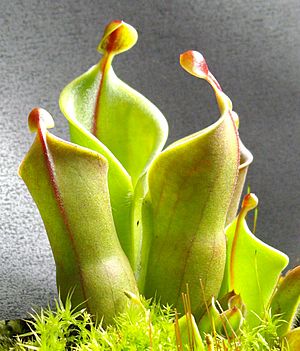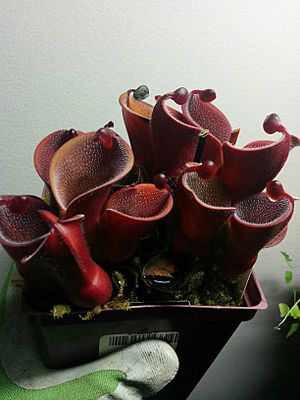Heliamphora minor facts for kids
Quick facts for kids Heliamphora minor |
|
|---|---|
 |
|
| Heliamphora minor growing on Auyán-tepui | |
| Scientific classification | |
| Genus: |
Heliamphora
|
| Species: |
minor
|
 |
|
| Native range | |
| Synonyms | |
|
|
Heliamphora minor is a special type of marsh pitcher plant. It gets its name from the Latin word minor, which means "smaller." This plant is found only in one place: Auyán-tepui in Venezuela. As its name suggests, it's one of the smallest plants in its group. It is closely related to other pitcher plants like H. ciliata and H. pulchella.
Growing Heliamphora minor
Heliamphora minor is one of the easier pitcher plants to grow. Many people like to keep it as a houseplant. It often grows well under bright lights in a terrarium. You can also grow it in a greenhouse with some sunlight.
Like other carnivorous plants, H. minor needs special water. It requires water that is free from minerals and chemicals. This means you should use distilled water or rainwater.
These plants can handle different temperatures. They prefer temperatures around 70–90 °F (21–32 °C) during the day. At night, the temperature should drop by about 10 degrees.
The soil for H. minor must not have many nutrients. Good soil mixes include washed sand, orchid bark, or sphagnum moss. You can also use peat moss and perlite.
Heliamphora plants also need a lot of humidity. The air should be at least 70% humid. A greenhouse or terrarium helps keep the air moist.
Types of Heliamphora minor
There are two main types, or varieties, of H. minor. One is called H. minor var. minor. The other is H. minor var. pilosa.
The pilosa variety has tiny hairs on the outside of its pitchers. Scientists are not sure why these hairs are there. One idea is that they might help stop crawling insects from reaching the nectar. This would save the nectar for flying insects. Another idea is that the shiny hairs might help flying insects see the plant better.
H. minor is similar to H. pulchella. One way to tell them apart is by their nectar spoons. The nectar spoon is a small part that holds sweet nectar. In H. pulchella, the spoon grows right on the pitcher's rim. But in H. minor, the spoon grows on a thin stalk. The spoon on H. minor is also usually larger.
A type once called Heliamphora minor f. laevis is now considered the same as H. minor var. minor.
Images for kids
See also
 In Spanish: Heliamphora minor para niños
In Spanish: Heliamphora minor para niños




